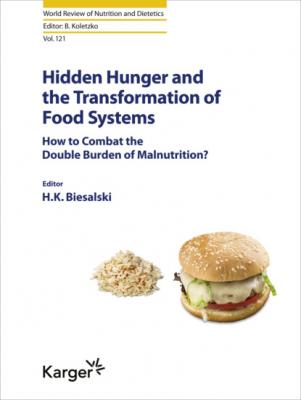Hidden Hunger and the Transformation of Food Systems. Группа авторов
Читать онлайн.| Название | Hidden Hunger and the Transformation of Food Systems |
|---|---|
| Автор произведения | Группа авторов |
| Жанр | Спорт, фитнес |
| Серия | World Review of Nutrition and Dietetics |
| Издательство | Спорт, фитнес |
| Год выпуска | 0 |
| isbn | 9783318066982 |
Fig. 2. Comparison of mean FVS (a) and DDS (b) for households shopping and not shopping in supermarkets. FVS based on food item count; DDS based on 12 food groups. Less healthy food items/groups excluded for FVS 2/DDS 2 are fats, oils, sugar, sweets, and spices. *** Difference between households shopping and not shopping in supermarkets significant at the 1% level. Authors’ presentation based on data from Debela et al. [24].
The nutritional improvements in children/adolescents through supermarket shopping seem to be mainly caused by increased dietary diversity [24]. Households that buy food in supermarkets have significantly higher food variety scores (FVS) and dietary diversity scores (DDS) than households that obtain all foods from traditional sources (Fig. 2). One concern could be that supermarket shopping would especially increase the consumption of unhealthy food items, which could drive up FVS and DDS without necessarily increasing dietary quality and micronutrient supply. However, significant differences also remain after excluding the food items/groups that are considered less healthy (Fig. 2). Even though supermarket shoppers consume more processed foods, their diets seem to be more protein and micronutrient rich, especially through higher and more regular consumption of animal-source foods [24]. These additional nutrients are beneficial for child growth, especially in situations where child stunting is still an issue.
Interventions Regarding Supermarkets
While there is a good body of literature on interventions regarding the food environment focusing on supermarkets and adults for the USA and other high-income countries, analyses for LMICs and/or including children and adolescents are very scarce. Hartmann-Boyce et at. [25] systematically reviewed randomized controlled trials and the changes in purchasing and consumption due to supermarket interventions. They found economic interventions, including discounts and vouchers, especially if enhanced by additional promotional activity, the most promising to change consumer behavior towards more healthy food purchases and consumption. The positive effects on behavior change are consistent for different levels of socioeconomic status. Findings by Adam and Jensen [26] underline these results. In their systematic review, they identified economic incentives, including price discounts, vouchers, and subsidies, as one of the strongest tools to change people’s purchase and consumption behavior towards healthier food choices. Besides changes in prices, Hartmann-Boyce et al. [25] predict promising effects through interventions on food swamps with healthier food options. Other interventions, like changing the store environment, including the placing and availability of food items, show mixed effects, and interventions that focus only on consumer education findings are positive in simulated environments, but no effects are detected in real store settings. The latter is partly confirmed by Adam and Jensen [26]; they found less than half of all studies focusing on information interventions to be effective in increasing the sales of healthy foods. Without looking into prices, Cameron et al. [27] identified shelf labeling (particularly using nutrition summary scores) as being particularly promising in regard to changes towards healthier food choices.
Overall, supermarket interventions, combining demand- and supply-side strategies, can be effective in changing people’s purchase and dietary behavior towards more healthy food choices [26, 28, 29]. However, translating the existing evidence into effects on levels of BMI or overweight/obesity is difficult. Furthermore, while the available reviews provide a good start for possible discussion and an overview of existing interventions, only a couple of studies looked at children, and only three of the studies were carried out in LMICs (one in Africa). This underlines an urgent need for further research in this area in different geographical and socioeconomic contexts.
Conclusion
Based on the findings reviewed here, the spread of supermarkets in Kenya has dissimilar effects for different groups of people. Supermarket shopping increases the consumption of processed foods, meat and fish, dairy and eggs, and vegetable oils, while it decreases the consumption of unprocessed staples and fresh fruits and vegetables. For adults, these dietary changes through supermarkets mean significant increases in BMI and diet-related NCDs. The studies showed higher levels of blood sugar and increased likelihoods of being overweight/obese, pre-diabetic, and suffering from the metabolic syndrome. While these effects clearly underline the contribution of supermarkets to the nutrition transition and the obesity pandemic in LMICs, the effects of supermarkets on children and adolescents are different. Supermarkets in Kenya do not (yet) seem to contribute to child overweight. Instead, supermarket shopping increases child linear growth and height-for-age Z-scores. The positive effect on child linear growth seems to be channeled through improved dietary quality. Despite higher levels of processed food consumption, supermarkets increase access to animal-source foods, leading to diets that are richer in protein and micronutrients. The dissimilar effects of supermarkets on adults and children are not completely surprising in the context of urban Kenya, where adult overweight/obesity rates are already high and growing further, whereas problems of child stunting are not yet overcome. Children can still grow in height through improved dietary quality, which is not the case for adults.
Most of the results reviewed here on the effects of supermarkets on adult and child nutrition are specific to Kenya and should not simply be extrapolated to other countries and regions. Related research is not available for other countries in Africa. However, we argue that some of the general findings – namely that the effects of supermarkets differ by age cohort – may also hold for other parts of SSA. Many other countries in Africa are also experiencing a rapid rise of supermarkets and a double or triple burden of malnutrition, where high rates of adult overweight/obesity coexist with child undernutrition and stunting.
The fact that supermarkets have both positive and negative nutrition and health effects makes the identification of suitable policy interventions more complex.
